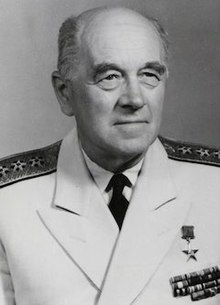Aksel Berg
Aksel Ivanovich Berg | |
|---|---|
 | |
| Native name | Аксель Иванович Берг |
| Born | 10 November [O.S. 29 October] 1893 Orenburg, Russian Empire |
| Died | 9 June 1979 (aged 85) Moscow, USSR |
| Allegiance | |
| Service/ | Imperial Russian Navy, Soviet Navy |
| Years of service | 1914-1953 |
| Rank | Admiral |
| Commands held | head of the Soviet Naval Research Institute |
| Battles/wars | World War I Russian Civil War World War II |
| Awards | Hero of Socialist Labour |
| Signature |  |
Aksel Ivanovich Berg (Russian: Аксель Иванович Берг; 10 November [O.S. 29 October] 1893 – 9 July 1979) was a Soviet scientist in radio-frequency engineering and Soviet Navy Admiral, Hero of Socialist Labour. He was a key figure in the introduction of cybernetics to the Soviet Union.[1]
Early life[edit]
Berg's father was General Johan (Ivan) Berg, of Finland-Swedish origin, and his mother was Italian. Aksel was 11 when his father died, and Aksel was matriculated to Saint Petersburg navy school. Berg joined the Imperial Russian Navy in 1914 and served as junior navigating officer on the Russian battleship Tsesarevich and as liaison officer on the British submarine HMS E8, which was operating in the Baltic in alliance with Russia.
Soviet times[edit]
Before the German-Soviet war[edit]
After the revolution Berg served in the Red Navy 1918–22. In 1918 he participated in the Ice Cruise of the Baltic Fleet. In 1919 he was navigating officer on the submarine Pantera when it sank the British destroyer HMS Vittoria. He subsequently commanded the submarines Rys, Volk and Zmeya. From 1925 Berg was based onshore and completed his education at the Saint Petersburg Polytechnical University. From 1927 he was assigned to the navy radio electronics department and from 1932 to 1937 he headed the Navy Communications Research Institute.
Imprisoned and rehabilitated[edit]
During Stalin's purges, Berg was imprisoned for three years, but was freed and rehabilitated in 1940, when Stalin became interested in developing radar. Berg was immediately appointed as minister of electronic technology of the USSR. He developed the Redut-K air-warning radar which was placed aboard the light cruiser Molotov in April 1941.[2] Molotov´s device enabled her to play a key role in the air defense of Sevastopol in the first stages of Operation Barbarossa.[3]
After the war[edit]
After the war Berg directed the Radioelectronics Institute 1947–57 and was a Deputy Minister of Defence 1953–57. Then in 1958 he founded and led the Scientific Council on Complex Problems in Cybernetics.[4] His main interests were radiolocation, microelectronics and cybernetics (i.e. computer science and radio-frequency engineering).
Death[edit]
Aksel Berg died in Moscow in 1979 and is buried at Novodevichy Cemetery.

Selected publications[edit]
Berg A., (1964), 'Cybernetics and Education' in The Anglo-Soviet Journal, March 1964, pp. 13–20 (English language)
Honours and awards[edit]
- Hero of Socialist Labour (10 November 1963) Decree of the Presidium of the Supreme Soviet "for outstanding achievements in the development of radio engineering and in connection with the 70th anniversary of Aksel Ivanovich Berg"
- Four Orders of Lenin
- Order of the October Revolution
- Order of the Red Banner, twice
- Order of the Patriotic War, 1st class
- Order of the Red Star, three times
- Popov Gold Medal (13 April 1951)
- Medal "For the Victory over Germany in the Great Patriotic War 1941–1945"
- Jubilee Medal "Twenty Years of Victory in the Great Patriotic War 1941-1945"
- Jubilee Medal "XX Years of the Workers' and Peasants' Red Army"
- Jubilee Medal "30 Years of the Soviet Army and Navy"
- Jubilee Medal "40 Years of the Armed Forces of the USSR"
- Jubilee Medal "50 Years of the Armed Forces of the USSR"
References[edit]
- ^ "Берг Аксель Иванович" [Berg, Aksel Ivanovich]. ETU «LETI» (in Russian). Retrieved 2020-09-17.
- ^ Watson, Raymond C. (2009).Radar Origins Worldwide. Trafford Publishing, p. 306. ISBN 1426921101
- ^ Yakubov, Vladimir; Worth, Richard (2009). "The Soviet Light Cruisers of the Kirov Class". In Jordan, John. Warship 2009. London: Conway. p. 88. ISBN 978-1-84486-089-0
- ^ Vegter, Wobbe. "Axel Ivanovich Berg". Wobbe Vegter. Retrieved November 17, 2012.
External links[edit]
- "Берг Аксель Иванович" [Berg, Aksel' Ivanovich]. Герои страны (in Russian). Retrieved 2022-05-31.
- 1893 births
- 1979 deaths
- People from Orenburg
- People from Orenburgsky Uyezd
- Soviet people of Finnish descent
- Soviet people of Italian descent
- Communist Party of the Soviet Union members
- Soviet admirals
- Imperial Russian Navy officers
- Soviet submarine commanders
- Soviet scientists
- Peter the Great St. Petersburg Polytechnic University alumni
- Full Members of the USSR Academy of Sciences
- Soviet prisoners and detainees
- Soviet rehabilitations
- Russian military personnel of World War I
- Soviet military personnel of the Russian Civil War
- Soviet people of World War II
- Heroes of Socialist Labour
- Recipients of the Order of Lenin
- Recipients of the Order of the Red Banner
- Burials at Novodevichy Cemetery
